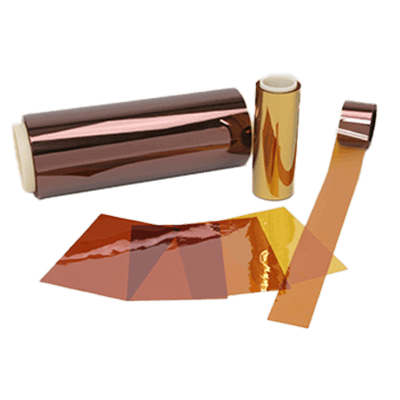What Is Polyimide Film?
 Polyimide is the most heat-resistant plastic among thermosetting resins due to its extremely strong molecular structure.
Polyimide is the most heat-resistant plastic among thermosetting resins due to its extremely strong molecular structure.
It also has excellent electrical properties such as high insulation, low dielectric constant, and body dielectric loss, as well as chemical and radiation resistance. It is an indispensable material for electrical and electronic equipment, various industrial equipment, and aerospace applications, and its low expansion coefficient relative to heat helps to minimize dimensional errors.
Its adhesion, soldering heat resistance, and dimensional stability contribute greatly to product miniaturization.
Applications of Polyimide Film
Polyimide Film is used as a substrate for precision flexible printed wiring and as an insulator for motor coils because of its low dielectric constant and low coefficient of expansion with respect to heat. They are incorporated into notebook computers and smartphones.
Polyimide is usually yellow or orange in color, but transparent types of Polyimide Film have a wide range of applications. They are used as substrates for smart glasses, next-generation display substrates, solar cell substrates, and other substrates that take advantage of transparency, as well as display devices such as touch panels and displays.
Principle of Polyimide Film
The main chain structure of polyimide consists mainly of aromatic rings (benzene and imide rings). The few freely rotatable single bonds mean that the conformational structure changes very little, resulting in a high glass transition temperature and melting point. This is the reason for polyimide’s high heat resistance.
Many Polyimide Films have a yellow or orange coloration, which is due to the formation of intra- and intermolecular charge transfer complexes based on the polarization of the imide ring. Polyimides that are colorless and transparent are required for use as optical materials, and examples include polyimides that are intentionally sterically hindered by substituents to create a non-planar structure and polyimides with an alicyclic structure.
When used as a substrate, it is important to keep the dielectric constant of the polyimide dielectric film as low as possible in order to increase signal speed. This can be achieved by introducing bulky linking groups in the main chain to reduce the proportion of imide rings with high polarizability, or by introducing fluorine or trifluoromethyl groups as substituents.
Types of Polyimide Film
1. General Purpose Polyimide Film
General Purpose Polyimide Film is the most common type of polyimide film and is used in a wide range of industries. Its main characteristic is its high heat resistance.
General purpose Polyimide Film typically has a heat resistance temperature of 200°C or higher, making it suitable for use in high temperature environments. They also have excellent chemical resistance and abrasion resistance, enabling them to withstand long-term use in a variety of environments.
2. Ultra High Heat-Resistant Polyimide Film
Ultra High Heat Resistant Polyimide Film is a type of film with even higher heat resistance than general purpose polyimide film. Heat resistance temperatures generally reach 300°C or higher, and it is widely used in demanding industrial fields and the aerospace industry, where it is necessary to use the film in high-temperature environments.
As a component of aircraft and space equipment, it is sometimes used as an insulating material in high-temperature parts of engines and propulsion systems. These films also play an important role in engines, high-temperature furnaces, electronic equipment, and other situations where insulation and protection are required in high-temperature environments.
3. Transparent Polyimide Film
Transparent Polyimide Film has the same properties as regular polyimide film, but with transparency. Ordinary Polyimide Film is generally non-transparent, but Transparent Polyimide Film is made transparent by a special process.
It is used in the manufacture of transparent components such as sensor covers for automobiles, high-temperature transparent bags, and optical sensors that require transparent windows in high-temperature environments. It can also be used in fields such as semiconductor manufacturing and optical equipment.
4. Adhesive-Backed Polyimide Film
Adhesive Polyimide Film is a type of polyimide film with an adhesive applied to one side of the film. This makes it easy to apply and is especially useful for assembling and protecting electronic devices and electrical components.
Adhesive-backed Polyimide Film is used to insulate wiring, protect components, and as a sealant in the manufacturing process of electronic devices. The film also retains its adhesive properties in high-temperature environments, making it suitable for protecting and insulating high-temperature components.